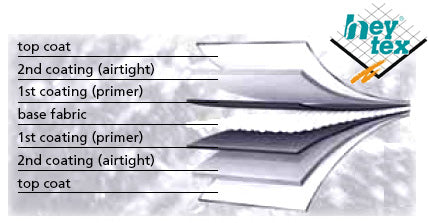
We have gotten loads of questions about inflatable sailboats. I am not going to go over every detail on this type of material, but if you are sketched out by the idea of an air-filled boat, hopefully, this will put your mind at ease.
I am only going to cover polytex boating material in this article; however, lower quality boats, such as pool toy quality versions will be made out of different materials.

Polytex is a layered plastic mesh. MiniCat sailboats use a multi-layer fabric consisting of a polyester fabric base layer, two inner polyurethane coating layers, and two outer PVC coating layers. The polyester fibers have incredible tensile strength, and also have superior abrasion and puncture resistance. The polyurethane layers double down on tensile strength and abrasion and puncture resistance. PVC layers ensure that the boat is airtight (pretty important for keeping the boat above the water) and UV resistant.
Polytex is made in many different weights and consistencies usually made for a specific purpose. There are three parts of the world that manufacture polytex fabric and there are different manufacturing standards for each country and, as expected they are not the same in terms of longevity:
Polytex made in China is expected to last at least 2 years. Polytex made in South Korea is held to a tighter manufacturing process and is expected to last at least 5 years. The material used for out boats is actually called HeyTex (the name of the manufacturer in Germany) and it is expected to get at least 10 years of life. I would even expect longer since our boats are seldom stored out in the sunlight and in the elements.
HeyTex 5509 is the exact material used for MiniCat sailboat hulls. HeyTex 5509 is one step up from the material used for other inflatable recreational boats. 5509 is recommended for rigid bottomed inflatable dinghies, life rafts (you know the ones you trust to save your life in the middle of the Atlantic Ocean), and white water rafts. 5509 weighs approximately 31 oz/yd², compared to the step down (what our competitors use) 25 oz/yd². To put it in another way our HeyTex 5509 is 35 MILS thick and the next step down is 28 MILS or less depending on country of origin. This is a huge difference in terms of keeping both the boat floating and you safe.
Not really about the material qualities itself, but inflatable boats are less prone to being holed than a rigid-hulled boat in an emergency situation. A solid hulled boat that "crashes" into solid rocks or God forbid another boat, damage can be expected. If you "crash" a 3 psi (the inflation pressure of MiniCat sailboats) into the aforementioned stuff, odds are you will just bounce off, causing no damage to either party. For reference, 3 psi on a boat hull is comparable to a properly inflated basketball.
The best quality of this synthetic material is the ability to be folded, over and over again. Without this incredible property, our boats simply could not exist. Bringing the sailing experience to those of us with storage woes is the single best attribute about this material, and by association, our boats.
Inflatable boats aren't for everyone, but are awesome for most of us! You just have to keep in mind, MiniCat isn't your grandfather's sailboat... it's better!
I am not a synthetic materials engineer, so please if I have made any errors, please feel free to correct me. I will gladly change any wrong information. I did do a fair amount of research and below are my sources:
HeyTex: http://heytex.com/en/portfolio-item/texineering-industrial-heyboats/#tab-id-1
HeyTex Brochure: http://heytex.com/en/portfolio-item/texineering-industrial-heyboats/#
Polymer Consulting: http://polymerconsulting.com.ua/en/materials/inflatable
